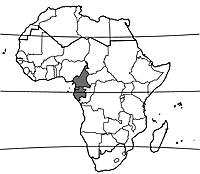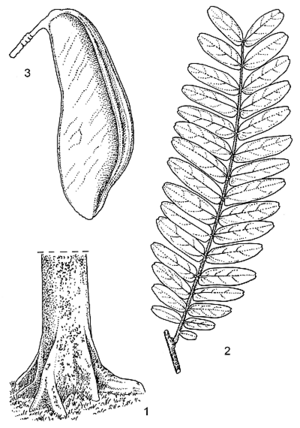Brachystegia mildbraedii (PROTA)
Introduction |
Brachystegia mildbraedii Harms
- Protologue: Notizbl. Bot. Gart. Berlin-Dahlem 8: 151 (1922).
- Family: Caesalpiniaceae (Leguminosae - Caesalpinioideae)
Synonyms
- Brachystegia nzang Pellegr. (1937).
Origin and geographic distribution
Brachystegia mildbraedii occurs in western Cameroon, Equatorial Guinea and Gabon.
Uses
The wood of Brachystegia mildbraedii, known as ‘bomanga’ or ‘ekop évène’, is used indoors in construction and for furniture and cabinet work. It is suitable for joinery, interior trim, ship building, vehicle bodies, toys, novelties, boxes, crates, veneer and plywood. The bark is used to make grain sacks, game nets, snares, clothes and water baskets.
Production and international trade
The wood of Brachystegia mildbraedii is locally important, but it is only traded internationally in mixed consignments.
Properties
The heartwood is medium brown and not distinctly demarcated from the yellowish white, up to 15 cm wide sapwood. The grain is usually wavy or interlocked, texture coarse. The wood often shows a roe figure and is lustrous. It is medium-weight, with a density is 500–620 kg/m³ at 12% moisture content. The wood air dries with some difficulty, but kiln dries well if carefully and closely stacked. Kiln drying of 2.5 cm thick boards from green to 12% moisture content takes about 7 days. The rates of shrinkage are moderate, from green to oven dry 3.3–5.2% radial and 6.5–8.0% tangential. Once dry, the wood is moderately stable to stable in service.
At 12% moisture content, the modulus of rupture is 90–163 N/mm², modulus of elasticity 7940–10,790 N/mm², compression parallel to grain 39–59 N/mm², shear 5.5–9.0 N/mm², cleavage 10–18 N/mm and Chalais-Meudon side hardness 1.7–4.1.
The wood is moderately easy to work, with a moderate blunting effect on saw teeth and cutting edges. It has some tendency to pick up on planing; a cutting angle of 10° usually gives a good finish. The wood glues fairly well and finishes, stains and polishes fairly well if a filler is applied. The wood is not durable, being moderately susceptible to attacks by termites, powder-post beetles, marine borers and Lyctus borers. It is vulnerable to blue stain fungal attack. It is moderately permeable to preservatives.
Description
- Evergreen, medium-sized to large tree up to 40(–50) m tall; bole branchless for up to 20 m, straight and cylindrical, up to 150(–200) cm in diameter, slightly thickened and fluted at base or with small buttresses; bark smooth, becoming rough and flaking off in irregular patches, pinkish grey to dark grey, often with greenish patches, inner bark thick, hard, fibrous, dirty pink to orange-red, turning brown upon exposure; crown rounded, rather open, with ascending branches; twigs glabrous to slightly hairy, blackish, with scars of bud scales at base and with numerous lenticels.
- Leaves alternate, paripinnately compound with (5–)9–16(–20) pairs of leaflets; stipules early caducous; petiole 0.5–1 cm long, thickened at base, rachis 10–25 cm long, rusty hairy; leaflets opposite, sessile, obliquely oblong, 1.5–5(–10) cm × 0.5–1.5(–4) cm, rounded at base, slightly notched to short-acuminate at apex, papery to slightly leathery, nearly glabrous, pinnately veined with up to 14 pairs of lateral veins.
- Inflorescence a terminal or axillary, rounded, short panicle, strongly branched, densely hairy, many-flowered.
- Flowers bisexual, nearly regular, small, fragrant, at base with 2 ovate bracteoles c. 6 mm long; pedicel 2–3 mm long; sepals (3–)5, slightly unequal, 1–2 mm long, nearly glabrous; petals absent; stamens 10, free, c. 1 cm long; ovary superior, ellipsoid, c. 3 mm long, with stipe, hairy, style slender.
- Fruit an oblong to obovoid, flattened pod 20–30 cm × 6–10 cm, at a right angle to the stipe, smooth but slightly wrinkled, reddish brown to dark brown or nearly black when ripe, dehiscent with 2 woody valves, 2–4-seeded.
- Seeds disk-shaped, c. 3 cm in diameter, dark brown.
Other botanical information
Brachystegia is a taxonomically difficult genus comprising about 30 species, distributed in mainland tropical Africa and South Africa, the majority of species occurring in southern tropical Africa, where they are characteristic of miombo woodland.
Anatomy
Wood-anatomical description (IAWA hardwood codes):
- Growth rings: 1: growth ring boundaries distinct; 2: growth ring boundaries indistinct or absent.
- Vessels: 5: wood diffuse-porous; 13: simple perforation plates; 22: intervessel pits alternate; 23: shape of alternate pits polygonal; 26: intervessel pits medium (7–10 μm); 29: vestured pits; 30: vessel-ray pits with distinct borders; similar to intervessel pits in size and shape throughout the ray cell; 42: mean tangential diameter of vessel lumina 100–200 μm; 46: ≤ 5 vessels per square millimetre; 58: gums and other deposits in heartwood vessels.
- Tracheids and fibres: 61: fibres with simple to minutely bordered pits; 66: non-septate fibres present; 69: fibres thin- to thick-walled.
- Axial parenchyma: 80: axial parenchyma aliform; (81: axial parenchyma lozenge-aliform); (82: axial parenchyma winged-aliform); 83: axial parenchyma confluent; 85: axial parenchyma bands more than three cells wide; 89: axial parenchyma in marginal or in seemingly marginal bands; 92: four (3–4) cells per parenchyma strand; 93: eight (5–8) cells per parenchyma strand.
- Rays: 96: rays exclusively uniseriate; (97: ray width 1–3 cells); 104: all ray cells procumbent; 116: ≥ 12 rays per mm.
- Storied structure: 122: rays and/or axial elements irregularly storied.
- Mineral inclusions: 136: prismatic crystals present; 142: prismatic crystals in chambered axial parenchyma cells.
Growth and development
Brachystegia mildbraedii is evergreen, but sheds its leaves briefly in the dry season. The fruits open explosively, dispersing the seeds over short distances. As a result, seedlings and saplings are most common close to the parent tree.
Ecology
Brachystegia mildbraedii occurs in evergreen forest, often on slopes, up to 1000 m altitude. It grows on shallow soils derived from shale or quartzite, which are poor in nutrients.
Management
Brachystegia mildbraedii occurs scattered in the forest or in small groups. In forest in south-western Cameroon, the average density of trees with a bole diameter of more than 60 cm is 0.3 tree/ha, with an average wood volume of 3.2 m³/ha, but Brachystegia mildbraedii is not distinguished from Brachystegia laurentii (De Wild.) Louis ex Hoyle, which probably provides the largest share in these figures.
Harvesting
In Gabon the minimum bole diameter allowed for harvesting is 70 cm.
Handling after harvest
Freshly felled logs should be treated with preservatives or processed soon after felling to avoid blue stain attack.
Genetic resources
It is unlikely that Brachystegia mildbraedii is in immediate risk of genetic erosion because it is locally common and not much traded internationally. However, some care is needed because it has a limited area of distribution and may become endangered in regions subject to forest degradation and selective felling.
Prospects
Brachystegia mildbraedii will continue to provide a useful timber of local importance, but it should be managed properly to ensure its sustainable use. It is unlikely that it will become important on the international market due to its scattered occurrence.
Major references
- ATIBT (Association Technique Internationale des Bois Tropicaux), 1986. Tropical timber atlas: Part 1 – Africa. ATIBT, Paris, France. 208 pp.
- Aubréville, A., 1970. Légumineuses - Césalpinioidées (Leguminosae - Caesalpinioideae). Flore du Cameroun. Volume 9. Muséum National d’Histoire Naturelle, Paris, France. 339 pp.
- Bolza, E. & Keating, W.G., 1972. African timbers: the properties, uses and characteristics of 700 species. Division of Building Research, CSIRO, Melbourne, Australia. 710 pp.
- CIRAD Forestry Department, 2008. Bomanga. [Internet] Tropix 6.0. http://tropix.cirad.fr/ africa/ bomanga.pdf. October 2011.
- de Saint-Aubin, G., 1963. La forêt du Gabon. Publication No 21 du Centre Technique Forestier Tropical, Nogent-sur-Marne, France. 208 pp.
- Letouzey, R. & Mouranche, R., 1952. Ekop du Cameroun. Centre Technique Forestier Tropical, Nogent-sur-Marne, France. 81 pp. + 20 plates.
- Sallenave, P., 1964. Propriétés physiques et mécaniques des bois tropicaux. Premier supplément. Centre Technique Forestier Tropical, Nogent-sur-Marne, France. 79 pp.
- Tailfer, Y., 1989. La forêt dense d’Afrique centrale. Identification pratique des principaux arbres. Tome 2. CTA, Wageningen, Pays-Bas. pp. 465–1271.
- Vivien, J. & Faure, J.J., 1985. Arbres des forêts denses d’Afrique Centrale. Agence de Coopération Culturelle et Technique, Paris, France. 565 pp.
- Wilks, C. & Issembé, Y., 2000. Les arbres de la Guinée Equatoriale: Guide pratique d’identification: région continentale. Projet CUREF, Bata, Guinée Equatoriale. 546 pp.
Other references
- Aubréville, A., 1968. Légumineuses - Caesalpinioidées (Leguminosae - Caesalpinioideae). Flore du Gabon. Volume 15. Muséum National d’Histoire Naturelle, Paris, France. 362 pp.
- Davy, B.J. & Hutchinson, J., 1923. A revision of Brachystegia. Bulletin of Miscellaneous Information Kew 1923(4): 129–163.
- Normand, D. & Paquis, J., 1976. Manuel d’identification des bois commerciaux. Tome 2. Afrique guinéo-congolaise. Centre Technique Forestier Tropical, Nogent-sur-Marne, France. 335 pp.
- Raponda-Walker, A. & Sillans, R., 1961. Les plantes utiles du Gabon. Paul Lechevalier, Paris, France. 614 pp.
- Takahashi, A., 1978. Compilation of data on the mechanical properties of foreign woods (part 3) Africa. Shimane University, Matsue, Japan. 248 pp.
Sources of illustration
- Letouzey, R. & Mouranche, R., 1952. Ekop du Cameroun. Centre Technique Forestier Tropical, Nogent-sur-Marne, France. 81 pp. + 20 plates.
- Wilks, C. & Issembé, Y., 2000. Les arbres de la Guinée Equatoriale: Guide pratique d’identification: région continentale. Projet CUREF, Bata, Guinée Equatoriale. 546 pp.
Author(s)
- J.K. Mensah, Forestry Research Institute of Ghana (FORIG), University P.O. Box 63, KNUST, Kumasi, Ghana
Correct citation of this article
Mensah, J.K., 2012. Brachystegia mildbraedii Harms. [Internet] Record from PROTA4U. Lemmens, R.H.M.J., Louppe, D. & Oteng-Amoako, A.A. (Editors). PROTA (Plant Resources of Tropical Africa / Ressources végétales de l’Afrique tropicale), Wageningen, Netherlands. <http://www.prota4u.org/search.asp>.
Accessed 31 May 2025.
- See the Prota4U database.


